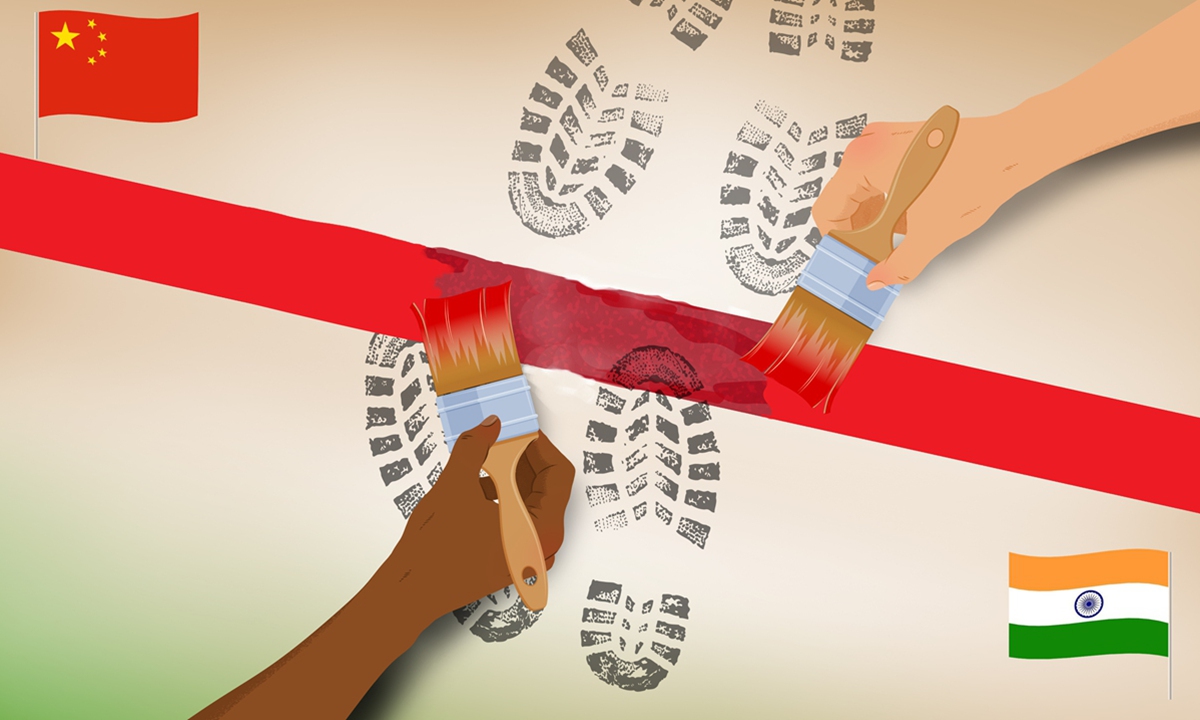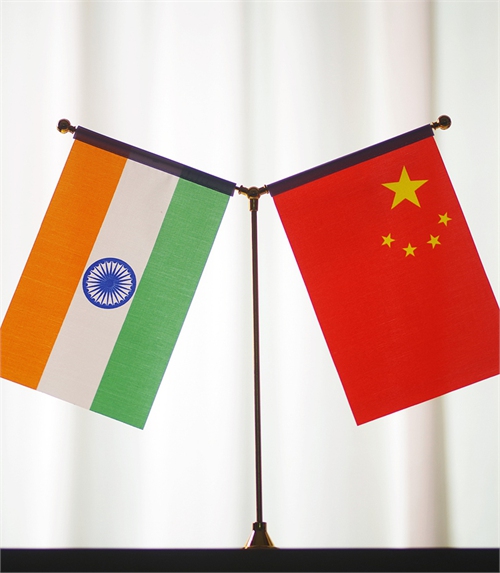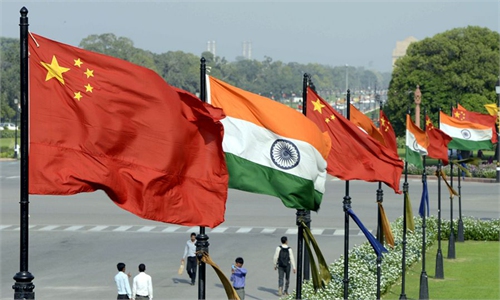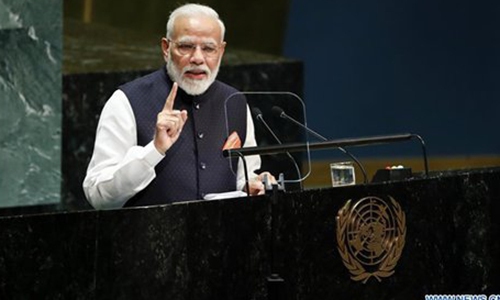Indian media hype of village construction in South Tibet shows intent to covet LAC area

China India Photo: GT
Indian media started hyping China's construction of a village in a "disputed area," saying the construction was built within Indian territory, which New Delhi is concerned about. But a Chinese expert said the move stirs anti-China sentiment, as the construction occurred within Chinese territory and serves the right purpose of improving lives of border inhabitants.
Indian media NDTV reported on Monday that China built a village of 101 houses in the so-called "Arunachal Pradesh," which China calls South Tibet or Zangnan. Using so-called satellite images dated November 1, 2020, NDTV said the village is located on the banks of the River Tsari Chu, which lies in the "disputed area."
India claims this area is its territory, but the Chinese government has never recognized the so-called "Arunachal Pradesh."
NDTV claimed that "the construction, approximately 4.5 kilometers within Indian territory of the de facto border, will be of huge concern to India."
The media also cited Claude Arpi, an expert in India-China relations, saying that "[this] is an extraordinarily serious issue as it has many other implications elsewhere on the boundary.''
The Indian media reports were "a blatant attempt to stir up troubles on the China-India border," Zhang Yongpan, a research fellow of the Institute of Chinese Borderland Studies of the Chinese Academy of Social Sciences (CASS), told the Global Times on Tuesday.
"The report distorts facts, which jeopardizes the two countries' efforts to maintain peace and tranquility in the border areas."
So-called "Arunachal Pradesh" was founded illegally in the last century and occupies about 90,000 square kilometers of Chinese territory.
The area has never been recognized by the Chinese government and Chinese ethnic minority groups such as the Moinba, the Lhoba and Tibetan people live in the area.
Qian Feng, director of the research department at the National Strategy Institute at Tsinghua University, told the Global Times that he suspects it is another move by Indian media to hype anti-China sentiment.
"China and India haven't demarcated the border line of this area yet. So they cannot accuse China of building a village on the Indian side," said Qian.
Echoing Qian, CASS research fellow Zhang stressed the McMahon Line in the eastern section was even more without legal basis.
The Chinese government has never recognized this line, Zhang said.
"It's absurd for the Indian government to use this line to determine the territory administered by China and India. Indian media should not bring about the issue when the country is still plagued by the serious situation of a COVID-19 pandemic."
Meanwhile, the River Tsari Chu, also known as the Majidun River, is a tributary of the Xibaxia Qu River (called the Subansiri River in India) in China's Tibet Autonomous Region.
There is no doubt that the River Tsari Chu basin is an inherent part of China's territory, Zhang said.
According to Zhang, historically, these areas were under the jurisdiction of the local government of China's Tibet. Some foreign travelers even visited these areas before India's independence.
In recent years, China has attached great importance to the construction of comfortable villages for the people of all ethnic groups in Tibet.
Under the leadership of the Communist Party of China, these villages have been fighting against poverty, enabling the people to live in good houses and have access to good roads, Zhang noted.
These border villages have been able to lift themselves out of poverty in recent years.
"China's actions demonstrate that the country has strictly respected and abided by the Line of Actual Control (LAC) between the two sides," Zhang said.
"China has also been working hard to maintain peace and stability along the LAC at the China-India border."
He slammed the Indian media for fabricating facts and stirring up troubles in the eastern section of the border with an attempt to divert public attention and revive the crisis of the 1950s.
Even another Indian media claimed NDTV misled with its "exclusive" report, saying that the Ladakh standoff had nothing to do with this development at all, and none of the villages was to be beyond Chinese borders.
"The village has been built along the Chinese Xingquionpuzhang to Migyitun Defense highway. The highway goes 2-3 km beyond the village, all within Chinese occupied territory and Migyitun township, as shown by a township map of China. Hypothetically speaking, if this village was inside Indian territory, how would Chinese maintain it?" the report asked.
But the report said the aim of these villages was to relocate the villagers to border areas to ring-fence the control around Tibet and its population more tightly as part of "its occupation of Tibet and to control Tibetan people's passage into India," which Chinese experts denied, stressing that building border villages aims to vitalize border areas and enrich the people living there.
"The Tsari region mentioned by Indian media is an important pass leading from the Himalayas to the southern mountain regions. It belongs to China, and India has been coveting this area. Indian media's provocation shows the country aims to continue its ambition: constantly provoke disputes and advance toward the LAC area," Zhang said.
"Even some top Indian strategic elites do not have a profound understanding of the Tibet question. They have never realized how sensitive the Tibet question is for China-India relations. By playing the 'Tibet card,' these people are playing with fire," said Liu Zongyi, secretary-general of the Research Center for China-South Asia Cooperation at the Shanghai Institutes for International Studies.
Whether it is the "Tibet card" or economic decoupling with China, these Indian scholars are just playing the role of some forces' megaphone. They have created such public opinion internationally and in India. This has done great harm to China-India relations, Liu said.
In recent years, China has been stepping up border construction in border areas to improve the living conditions of those who live along the border line, said Qian, noting that Indian officials and military are fully aware of the situation.
The expert said that so far, the Indian government made no public comment on this matter. It reflects the wrong understanding of the border issue embedded in some Indian elites.
India's Foreign Ministry did not respond directly to NDTV about the question on whether the village construction has been diplomatically raised with Beijing.
It said, ''The government keeps a constant watch on all developments having a bearing on India's security and takes all the necessary measures to safeguard its sovereignty and territorial integrity.''
Relations between China and India nosedived since a deadly confrontation in Galwan Valley last year. In November 2020, the two sides began formulating a disengagement plan to withdraw troops and establish no-patrol zones.
Yet some Indian media did not stop hyping border issues involving China and neighboring South Asian countries. The most recent one can be traced back to November 2020, when NDTV hyped that China has built "a residential area," which it referred to as "Pangda village," two kilometers within Bhutanese territory, which was later confirmed by the Global Times as within Chinese territory.
Pangda village belongs to Yadong county, which borders Bhutan on the eastern and southern side while bordering Sikkim, India on the western side. In 2017, China-India tensions escalated due to the Doklam standoff, which occurred in the border area of Yadong.
The location in South Tibet is roughly 750 kilometers away from Pangda village.
Hu Zhiyong, a research fellow at the Institute of International Relations of the Shanghai Academy of Social Sciences, told the Global Times that it is India who has stepped up construction in the border area with China, but those news never made headlines in Chinese media.
This was echoed by India's Hindustan Times, which cited sources who said that India has bolstered the construction of infrastructure in the so-called "Arunachal Pradesh" and there have been instances of local commanders holding meetings to discuss structures falling in disputed areas.
The standoff between China and India concentrated on the western side of border for most of the time in 2020, said Qian, noting that although the situation is under control now, it has not toned down.
"We need to pay attention in case such confrontation extends to the eastern end, such as South Tibet. Media hype may serve to test China for some people in India," said Qian.
He said China's policy toward India remains consistent, and it won't start provocations against New Delhi. "But India should not underestimate China's determination to safeguard its sovereignty. Any inappropriate behavior will invite China's countermeasures to protect its own interests," said Qian.





